New Details in the Proposed Cary Towne Center Redevelopment
Cary, NC – The rezoning and redevelopment of Cary Towne Center comes before Town Council at the end of 2019. This week, the Planning and Zoning Board met to look over the proposal, as well as new conditions and the architectural design guidebook.
Plan for the Mall
The proposed rezoning would turn the entire 87.26 acre site where Cary Towne Center and its surrounding businesses are currently and turn it to a Mixed Use Development site, with a Preliminary Development Plan (PDP) to lay out specific uses throughout the site, as well as the building phases for this all to come in.
The color-coordinated PDP calls for the yellow blocks to be primarily residential, the orange to be primarily retail and commercial, the blue to be primarily office and institutional and the green to be a mix of office and commercial. In the PDP, nearly all of these blocks also have the potential for a secondary commercial use.
In total, the PDP calls for:
- 600,000 to 1.2 million square feet of office and institutional buildings
- 900 to 1,800 residential units, with a limit of 175 townhomes
- 100,000 to 360,000 square feet of commercial buildings
- between 90 to 450 hotel rooms
For a hotel, the PDP allows for one to built everywhere but blocks 1-4 and 15-18.
Each block also specifies the height limits, with the tallest buildings by the SW Maynard Road and Cary Towne Boulevard intersection. Those central six blocks – 5, 6, 9, 10, 11 and 12 – are also specified as Cary Towne Center’s “urban core,” where some building heights can be limited to one floor and where design restrictions on signage are reduced.
Currently, the PDP designates the Belk and Sears buildings as structures that can stay standing and be redeveloped, though that is not a guarentee.
“It’s a fair assumption that everything can go away, down to Walnut Street,” said Planning and Zoning Board member Steven Crutchfield.
There will also be a parking deck on the site, which conditions say will hold 70 percent of Cary Towne Center’s parking. All three of the vehicle corridors have parallel parking on them, with Corridor A in blue the widest at 90 feet and also including a separated bike path and two sidewalks. Corridor C, in orange, is the narrowest at 65 feet and it’s primarily meant to connect drivers to the residential blocks.
Additionally, there would be four bicycle circulation paths and dedicated “bike boulevards.”
New Conditions and Changes
Since the rezoning came before the Cary Town Council for a Public Hearing in August this year, there have been new conditions added. One of these, mentioned above, is the limit on the number of townhomes in the residential area. The developers have also included planting 1,100 new canopy trees as a conditon.
Along Walnut Street and SW Maynard Road, the streetscape will be reduced to 20 feet and would be a more “urban streetscape” as described by Katie Drye with Cary’s planning department. This is smaller than Cary’s current ordinance, and the applicants are also proposing internal streetscapes inside Cary Towne Center, using their own design standards. For the exterior streetscape there currently, including the wooden steps into the mall property, the applicant said those would be removed. The applicants have also committed to keeping the berm between the mall property and the nearby neighborhood.
Other proposed changes to Cary’s Land Development Ordinance is limiting the number of drive-thru businesses to three and none of these can be restaurants. Also, there would be no cross-access between the mall and the gas station at the intersection of SW Maynard Road and Walnut Street. There are three champion trees on the property the developers are proposing to remove.
Because of the amount of office being proposed, the applicants also attached an option of reducing parking by 30 percent of what Cary requires, saying it is because people working at these offices would mostly not be parked here at night.
“We’ve been seeing this happen a lot lately,” Crutchfield said. “It’s a bit concerning.”
One procedural ordinance change here is an extension on a building deadline. Typically, after a rezoning, a developer has two years to build a structure for 100 or more residents or a 100,000 square foot or more non-residential building, or else they have to go into a quasi-judicial meeting if they want to build that. But because of the size of the project and how long it will take to build, the applicants are asking for this deadline to be extended until 2030.
The Cary Community Plan puts this site in the Eastern Gateway and specifically calls for this to be one of the most densely developed parts of Cary. But Planning and Zoning Board member Nicole Samuel said the Cary Community Plan also calls for more affordable housing and asked if that was being included here, since there is no condition for affordable housing currently.
“There’s a potential for so many residential units here,” Samuel said. “Also, the proposal is encouraging people to live where they work.”
Design Guidelines
Also attached with this rezoning is an design guidebook, which is a zoning condition and supersedes Cary’s appearance manual for this site.
For all building types, the guidebook calls for a mix of exterior materials, as well as keeping buildings in line with regional looks, e.g., brick, steel, glass. Nearly every building type also calls for visibility inside, or at least visibility into lobbies when it comes to hotels and residential buildings.
The design guidebook also goes into the design of community gathering areas and the opportunities for seasonal and temporary activities and events on these sites.
Additionally, the guidebook goes into the signage allowed here, and while, for example, signs on roofs or neon signs would not be permitted under Cary ordinances, and are not allowed in most of the blocks in this Cary Towne Center rezoning, they would be allowed in that central urban core.
Planning and Zoning board member Jessica Pearson, who has a background in architecture, said looking at the guidebook will be important because in large developments such as the new Cary Towne Center, there can be a “sameness” to the buildings.
“They don’t promote the variety and interest a community needs,” Pearson said.
At the August 2019 Town Council meeting, Cary Mayor Harold Weinbrecht also specifically said he wanted to see the guidebook to get a better idea of what’s being proposed for the mall.
The Planning and Zoning Board will vote on their recommendation at their Monday, November 18, 2019 meeting, which will follow the rezoning to its vote in front of Cary Town Council at their Thursday, December 12, 2019 meeting. This will also be the first meeting with newly elected Council Member Ya Liu.
Both the PDP and the design guidebook are available on the Town of Cary website for public view.
Story by Michael Papich. Photos courtesy of the Town of Cary.

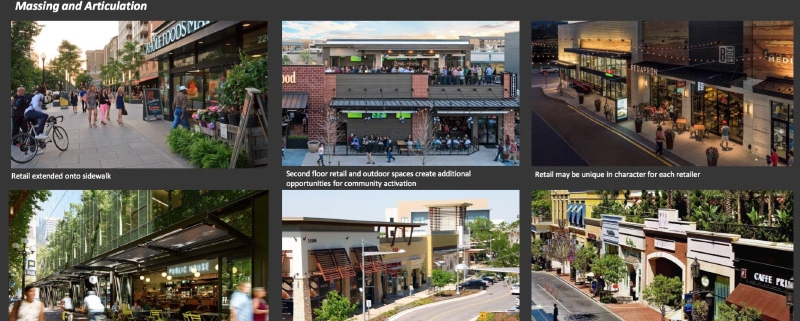



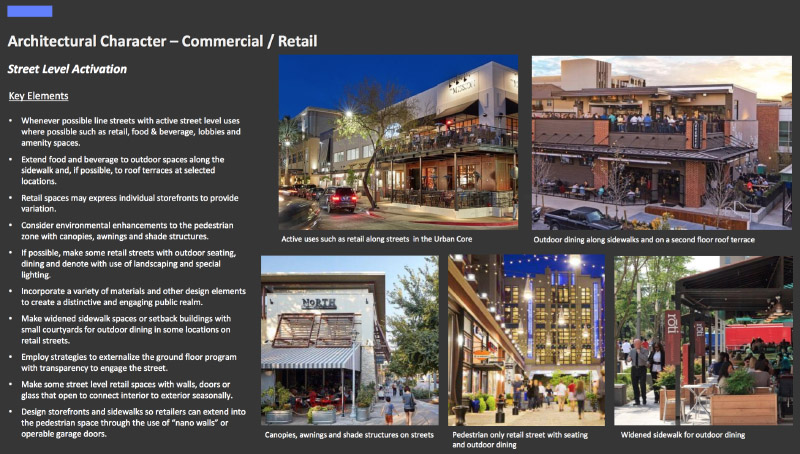
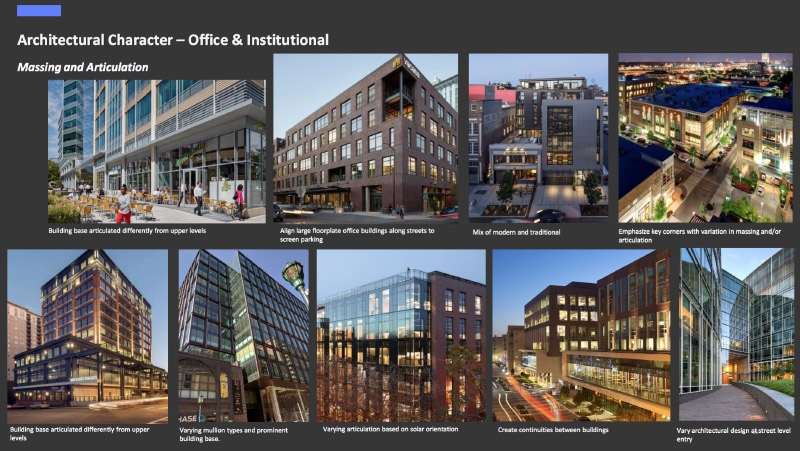
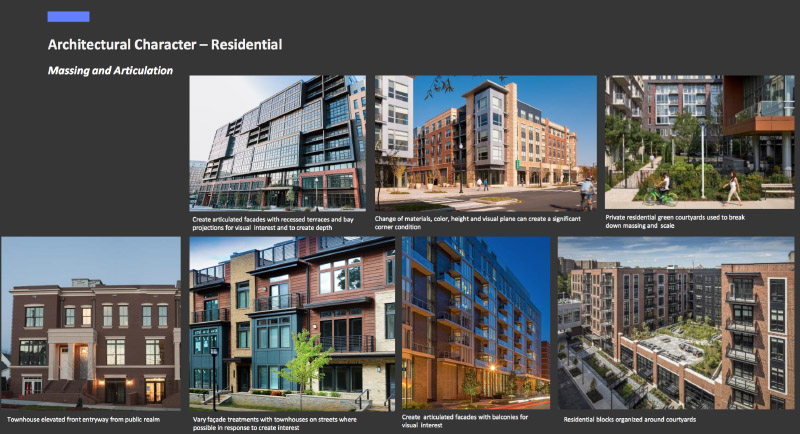
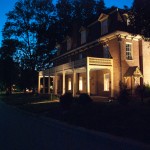

As we have clear-cut trees in our developments, we’ve blithely assumed that our air would be purified and our oxygen produced by trees located “somewhere else.” But the “somewhere else’s” of the world are disappearing at an exponentially-increasing rate. It is time that we realize that the right to develop property generates reciprocal obligation.
Future development must be such that it produces less air pollution than before construction, and produces more oxygen after than before. It is time to end the developers’ shifting the burden of pollution reduction and oxygen production to society in general – that is, the rest of us.
I moved here from Los Angeles where the traffic is horrific all day long and the houses are crammed together on small lots. Most of the mixed usage developments there struggle to find shops that can make it because of the high rents. And even here, at Park West, the shops and restaurants struggle. Starbucks, Charming Charlie, and others have gone under there. Why keep building these “mixed usage” large developments if they constantly struggle to attract businesses and residents? Because this area is raised up from the street level on two sides also makes it unappealing to potential shoppers. If you can’t see what’s there driving by, the chances of people stopping are greatly reduced. A better use for this area would be a few homes, restaurants, and a park for Cary families to enjoy. Leave the three trees alone, too!
Karen writes ‘Starbucks, Charming Charlie, and others have gone under there.”
The Strarbucks didn’t have a drive-through and couldn’t add one. It had decent foot traffic but parking and grabbing a cup to go was a challenge. It isn’t like Starbucks went bankrupt, the location just didn’t meet expectations and couldn’t be fixed. My son worked there for several months.
Park West certainly could have been designed better, navigating around the various sections is a pain. It is too big to park and walk everywhere if you’re doing much shopping. Getting to Earthfare coming from Cary Parkway requires navigating across the entire center because the light on Chapel Hill doesn’t have a protected left-turn signal, or you can go down to Morrisville Parkway. The left turn off of Chapel Hill is pretty useless at any time there is traffic. Leaving Park West from Target and turning left on to Cary Parkway is a challenge without a protected left-turn signal, you’re looking up over the crest of the road to try to turn left while people coming out of the Food Lion center are gunning across Cary Parkway for Target.
I’m not sure what the occupancy rate is at Park West but it is fairly high. That said, wish they hadn’t clear cut a great bandit mountain bike area. But since I didn’t have a few tens of millions of dollars to buy it I can’t complain when the owner decided to sell.
I am concerned about a few things mentioned, as well as something that has not been brought up.
First, I agree that this proposal is much too dense for Cary. Secondly, I agree the GoTriangle/GoCary routes throughout the center is a necessity.
Finally, something that is a problem all around Cary. It is the lack of convenient Handicapped Parking spaces. Many locations seem to have too little or far away Handicapped Parking. The town should require plenty of Handicapped Parking, both in the parking garage AND in the parallel parking on all the roadways in this plan!!!
And the Town of Cary needs to provide and enforce more Handicapped Parking spaces in all future development projects, as well as possibly going back to previous developments (e.g.; Harrison Square, The Arboretum, Downtown Cary and more.) Morrisville l, also, needs to add more accessible parking spaces to shopping centers, like Park West. Although, Target does a good job of centralizing its Handicapped Parking spaces, plus has extra spaces at the closest ends of the many rows. However, in the Park West District area, especially near the movie theater and restaurants, there are very few accessible spaces.
Police enforcement needs to crack down on illegally parked cars in these spaces, as well as in time-limited spaces—where those with Handicap Placards may park as long as necessary, according to NC law. Many people park indefinitely, without have a placard or permanent license tag.
All these opinions are my own, yet numerous non-handicapped people, including business owners, have agreed with me.
FYI, I have been permanently disabled for 16 years, and get frustrated and winded whenever I cannot find a close space to park.
Thank you for listening to these remarks. Hopefully, they will be taken into account for this proposal, along with the other locations.
Barry Shafer
Cary, NC
Hear, hear!
I am very happy to see the Town of Cary addressing the problem with Cary Towne Center. It was wonderful in it’s day, but shopping has changed and many towns are stuck with empty out-dated malls. This will give a new life to area. I do think that the developers should have to keep the champion trees. There’s no reason that they cannot revise their plans to incorporate those trees into the development.
Save trees
That worked out so well for the tree they “saved” by the food court entrance. If you weren’t here, or don’t remember what is now parking lot used to have a large mound of dirt, like over 1 story tall mound of dirt with a tree on it. The tree died and then the mall was able to cut it down and clear out this large pile of dirt at great expense and haul it away. There is going to be a lot more green space in this new design than ever could have been possible in the existing design. I’m all for trees, but the existing ones might just be in the way of good design.
It seems that Cary is just not content with what it is. A laid-back medium sized TOWN or putting structures that will clog the streets and turn people OFF. This whole thing is really ridiculous. I come from Los Angeles, was born there and go back frequently and see what an overbuilt monstrosity looks like. Keep Cary being Cary. Small, quaint with no more housing jammed in here. I can’t even get out of my street on to Waldo Rood because it’s now a cut-through street from Davis to Cary Parkway and visa versa. You have a large plot of land – you see an opportunity to generate more taxes, fees, and such from developers, yet this isn’t good for the community. More townhouses? More traffic? Jamming people in for what purpose exactly? I don’t approve of this project. More isn’t always better.
Hear, hear!
In the US, we have freedom of movement. That means that you can’t stop growth without either economic decline or loss of affordability. It’s supply and demand.
ECONOMIC DECLINE:
If we say “That’s it, no more people can move here” perhaps some of the industries that have located here for the quality of life and for the ease of recruiting people to live here will pick up shop and move out – we’ll wind up killing the goose that laid the golden egg. Now, perhaps some retired folks on a fixed income would prefer economic decline – if they are selfish. A surprising number of people actually will admit this, if confronted! But economic decline (perhaps locally; perhaps on a global scale) means pulling up the ladder that people can climb on to raise themselves out of poverty and improve their station in life. So, for people like us who work & pay to maintain the services and infrastructure everyone depends on, and who care about the welfare of humankind, I think economic decline is not a legitimate option.
AFFORDABILITY:
In this scenario, let’s assume that, like above, we say “OK, no more growth” – and for some reason, the industries don’t pick up and leave (The universities are a big part of the draw, and they aren’t going anywhere, for example) and the economy continues to grow – then people from elsewhere will continue to want to move here – and if there’s no new construction then they will bid up prices of the existing housing stock. This is exactly the scenario that is playing out – to a very extreme degree – in areas like the San Francisco Bay, where cheaply built 800 square foot bungalows on a tenth of an acre can sell for $2 million. If we chose the no growth option, and retain our economic vitality, that’s where we’re headed – they’re just 40 or 50 years further down that road than we are.
If you moved here some time ago and are all settled and have a lot of equity, and are only concerned about yourself, then you might not care about affordability – “We should demand development that serves US, the *current* residents of the town!” – or – “I got mine, and it’s pretty nice, so screw the rest of y’all!” But most of us who have children, or care about the future in general, are concerned that those who come after us should have the same opportunities that we had – to find employment, to buy a home, to build equity, to live a good life. So we don’t want a big hit to affordaibility either.
There is a misconception that growth and development CAUSES prices to go up, but the truth is actuallly the reverse. Growth and new construction *follow* an increase in prices, because that means developers can build more profitably. Clamping down on growth doesn’t preserve affordability, it just boosts the land values of those who already live there. Again, great if you only care about current homeowners. Not so great if you want future generations to have opportunities too.
OTHER POSSIBILITIES:
A common response to the above is “Let the people live somewhere else, like Detroit.” or “People should just stay where they are, don’t move here.” But again I remind you, in the US, we value freedom. Short of China-style restrictions on movement (where you need an internal passport and visa to legaly move from one place to another!) How do we accomplish this without eliminating the freedom of movement that makes our country so dynamic?
“But there are just too many people! Let’s fight overpopulation” is another common one. Now, I do agree with this, but the birth rate in the US is already below replacement. Actually, nearly every developed nation in the world is below replacement. So, this is not where the overpopulation problem originates. The solution to overpopulation is things like education, womens empowerment, access to birth control – and bascally just economic development in the places of the world with much higher birth rates. Short of draconian restrictions on reproduction (“One child” policy like China) or worse, things like widespread eugenics or outright genocide, there is no “silver bullet” quick solution. So, the world’s population will continue to grow. Fighting development in the US exerts no back pressure on the birth rate in India. Until such a day as this turns around, people will continue to need places to live.
GROWTH:
So, to me, the inescapable conclusion is that, unless we want to adopt openly misanthropic (at best) or genocidal (at worst) public policy, we can’t, and shouldn’t, stop growth. We should instead channel growth responsibly, while *not* trying to restrict its magnitude at all.
So, to channel growth responsibly, what should we do. locally? I would argue that we should oppose development on farmland way out in the countryside, not developments like CTC.
If you care about trees, then the trees at CTC should not be your primary concern. Now, I’m not saying that I am in favor of cutting the champion trees at CTC – I’d like to see a plan that leaves as many trees on site as possible – but it is mere virtue signaling, perhaps even hypocritical, to complain about cutting a few large trees at CTC, but to also say nothing about the new subdivisions going up on the edge of suburbia, where they regularly cut down hundreds of acres of forest to slap up a bunch of 4000 square foot monsters with three-car garages and strip malls with Publix and Wegmans. Those developments might be happening out-of-sight, out-of-mind – but be assured: they are happening, and they are HUGE. If you care about trees, the engine of suburban sprawl should be your target – not infill redevelopment in place of a big parking lot like this!
If you care less about trees and more about traffic, the result is the same. Developments like CTC enable people to live with less driving per person. Developments like this can feasibly be served by useful transit. Sure, not everybody will live where they work, and not everybody will use the transit, but it’s a mathematical fact that any new dwelling that gets built closer to the center of the region means less driving per person compared with the same amount of development at the outer fringe. It’s the developments way out in Fuquay, Pittsboro, Creedmoor, even places in the further reaches of West or South Cary, where everybody has a long drive to work – basically, where people drive more – that make the biggest contributions to traffic, and it is those that we should oppose.
CONCLUSION:
In conclusion – I must ask – what is the motivation of people who oppose this development? If you support the development but just want it to be as good as possible (*not* as small as possible) then good for you. But if you oppose it, what are your grounds? What better option do you suggest that (1) accommodates the same number of people (Remember, stopping growth has consequences!), (2) is economically feasible to build, but (3) causes less traffic and (4) keeps more trees than the proposed CTC development? I’d really like to know!
I agree with your sentiment. However, we’re running out of places to put things in the triangle because, well, Californians keep moving here… If you want small to say small, there have to be less people coming into the triangle, and that just isn’t the reality.
Wanting small to stay small, good, affordable, all while retaining freedom of movement, is an appealing thought but at the end of the day it is a fantasy.
If we’ve got something good, other people are going to want in. And again, in the US, we have freedom of movement, so what can we do to stop them? We can (1) Do something to make the region less attractive, like intentionally spike the local economy – making it so people don’t want to move here anymore, (2) stop construction, which makes it evenutally become so expensive that nobody can afford to move here anymore, or (3) implement large-scale restrictions on movement.
There are no other options.
Even some things commonly tried, even here in the US, such as social housing, rent control, and property tax caps, basically fall into category (3) and the come with all the negative side effects you’d expect. All of these allow existing residents to stay where they are, affordably, by keeping costs relatively static for them. But it also makes those same residents *trapped*, unable to move, lest they lose the sweet deal they have, and be forced to take a place at the back of a years-long waiting list for new housing, or get their property taxes reset to current rates (which they often can’t afford). None of these systems provide a satisfactory solution for future generations, either, given that population growth is still a fact.
If you want to live somewhere small, at this point, Cary isn’t it: it hasn’t been really small since the early 1970s. This is a booming suburb built on a strong economy and low costs of living, and growth is a fact of life here.
If you do decide to move somewhere Small and you want it to stay Small, be sure that you pick somewhere that has a means of repelling other newcomers: either heavy restrictions on growth and extremely expensive housing (I hear The Hamptons have a nice small town feel!), *or* a terrible economy/terrible weather that makes for badly suppressed demand (I hear Fairbanks is nice – that is, if you can deal with the 40-below temperatures, the constantly dark winters, the constantly bright summers, the mosquitoes, and the bears!)
All the facts you recite are true.
All the inferences you draw therefrom are valid.
The carbon dioxide count in our air recently hit 415.70 ppm, a concentration never before breathed by our race. It increases, inexorably.
Yesterday, our air-pollution ratings in Cary were: 67 ppm ozone [Moderate pollution] and 57 ppm particulate pollution [also Moderate pollution]. This in a city with NO heavy industry, only the addition of five cars per day, every single day, to our roadways.
As we continue to chop down trees and turn permeable ground into non-permeable ground, these numbers will worsen.
Query: What is the plan to stop this slide into an unsustainable situation that will eventually choke human beings? My sense is that it is simply to kick the can down the road to the next generation, and wish them the best of luck. But if I’m wrong – please tell me how I’m wrong.
Cary hasn’t been a medium-sized town for several decades. At over 150,000 residents it is larger than many cities across the country. It doesn’t have a central business district like Charlotte, Raleigh, Winston Salem and the like but it is a city-sized locale. It is a suburban city that spreads out until it bumps up against things like a state park, a large lake in another county or boundaries with another municipality.
Cary is not “content” with what it is; it is responding to current economic realities.
And it is not quaint, has not been quaint, was never quaint. If by that you mean small, and you’re from urban CA, then bad news. You’ve just moved from an old intensive growth area to a new intensive growth area, and the same things will be happening, until everyone involved gets with the environmentally responsible program regarding air, water and soil quality. But don’t hold your breath and there will still be lots of people.
Please no more cutting down of champion trees as is in this proposal: “There are three champion trees on the property the developers are proposing to remove.”
There were so many removed in front of the McDonald’s at Crossroads and recently all those huge trees at the corner of Kildaire and Cary Parkway.
Hear, hear!
Well-done article!
Sorta funny:
“limiting the number of drive-thru businesses to three and none of these can be restaurants”
So, no Panera, Chick-Fil-A, huh?
Meanwhile, every school in the Town has massive, multi-lane van-pool lanes twice a day, and in some places,
year-round!
Drive-thru schools are allowed?
I agree. And it should become a condition, that reduced parking mandates transit accommodation in recompense. Also, when the office workers go home (and who works 9-5 nowadays?), then the evening shopping and restaurant crowds show up and need parking. So the flow will change, but parking needs remain. North Hills, anyone?
I agree regarding the need for a GoTransit office, as a nice idea.
Vehicle, bike and pedestrian paths appear to be getting addressed, but still nothing regarding transit. A route following the dotted blue line from the Walnut St. light by Barnes & Noble either straight across to Cary Towne Blvd, or turning left to SE Maynard Rd would be nice.
It would also be helpful to have a GoTransit office in the complex for obtaining passes and special IDs, e.g., disabled, senior, etc., without current hassle of having to travel to the Regional Transit Center or downtown Raleigh to obtain them.